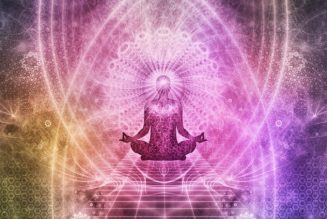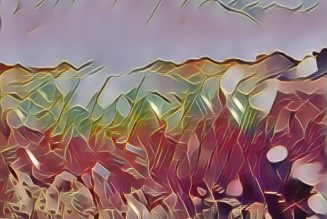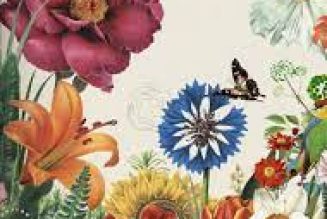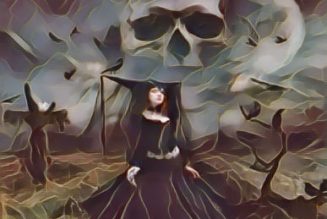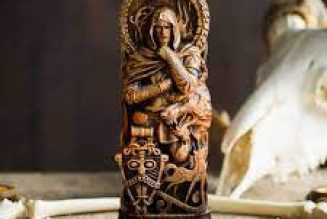
The cauldron is one of the most well-known of the witch’s tools. And I’d say, next to the broom, it’s the witch’s favorite tool! We have proof the cauldron’s been used since ancient times and it’s still in use today. The myth of the Cauldron of Inspiration gives us insight into just how important the cauldron was in the past. Learn all about the witch’s cauldron, it’s history and mythology, magical uses over the years and how to use a cauldron in YOUR practice today.
* First, What is a Cauldron?
A cauldron is defined as a “large metal pot with a lid and handle used to cook over an open fire.” The cauldron dates back to at least the late Bronze Age and was used for cooking and brewing purposes. The term “cauldron” is derived from old Norse and Germanic words meaning “hot place”. The term kettle is related to cauldron. (Fun fact, if your name is Corey, you are inherently linked to the cauldron since the word for cauldron in Middle-Irish is Coire).
At a time when electricity didn’t exist and survival during the cold months depended on fire, the cauldron was a symbol of protection and life. The cauldron came as a welcome change to cooking after many used an earthenware pot to heat their food and brews. This was more difficult because it required dropping hot stones into the pot to cook what was inside. The cauldron came along and made cooking and brewing easier. And it came to be associated with women’s magic and eventually the witch’s magic.
The Witch’s Cauldron’s Uses
* The Witch’s Cauldron as a Magic Symbol
The cauldron symbolizes many things, namely the Divine Feminine, because it is iewed as the womb. It is related to creation, as in the womb of the earth. And therefore it’s associated with witches and goddesses. Because food and ingredients for remedies are placed inside a cauldron and then transformed, the cauldron is a symbol of transformation and alchemy.
* Via Cerridwen’s Cauldron of Inspiration, it’s also a symbol of divine wisdom and rebirth. The four elements are an inherent part of every cauldron: the pot and food that goes inside, water and brews made inside, the fire that heats the cauldron, and the steam and smoke that comes out. The three legs represent the Celtic sacred number three: three main lunar phases, the life/death/rebirth cycle, and the triple goddess.
* The Witch’s Cauldron in Ancient Mythology: Cerridwen, Dagda and Medea
The cauldron has quite a few appearances in mythology. Perhaps one of the most famous of mythological cauldrons is Cerridwen’s cauldron – the Cauldron of Inspiration also called Awen (pronounced AH-OO-EN). Cerridwen is an ancient Welsh Celtic goddess of rebirth, magic, and wisdom. When she attempts to give wisdom to her son, her assistant Gwion Boch is asked to stir the cauldron. Three drops fall onto Gwion’s thumb and he licks it off. Then he becomes the otherworldly bard Taliesin. Therefore, the cauldron is a symbol of wisdom and transformation.
* Medea, the Dagda and Bran’s Cauldrons
Another cauldron in mythology is one used by the Greek goddess-priestess Medea. Medea is a priestess of the goddess Hecate who seeks to destroy the King Pelias with the use of her magic cauldron. In addition, the Dagda of the Irish Celtic pantheon, is said to have a cauldron that never runs out of food, heals all who need healing, and grants everlasting life. Bran’s cauldron is said to bring dead warriors back to life. Except, when they return from the cauldron of rebirth, they are unable to speak. Author John Matthews theorizes this is because they aren’t to speak of the Great Mysteries of the Otherworld, they are only to be experienced. There are many myths featuring the witch’s cauldron.
* King Arthur and the Holy Grail
The older versions of the King Arthur legend talks about a Cauldron of Inspiration and Rebirth. This sought-after magical cauldron came to be the “Holy Grail” in later versions. The cup and the cauldron both represent the feminine principle – the womb of creation. And therefore also represent fertility and sexual union when a phallic symbol like a knife is inserted into it. The same goes with a chalice or cup and a knife in Wiccan ritual.
* The Cauldron Carriers and Rosicrucians
According to Linda Raedisch in Night of the Witches, the Frankish tribes called men who carried cauldrons for witches a special term – chervoburgium. Sadly, this wasn’t a compliment…it was meant as an insult. And yet, we know other men of magical traditions enjoyed using and kept the cauldron sacred. The Rosicrucians, for example, said “We claim the cauldron of the witches as, in the original, the vase or urn of the fiery transmigration, in which all things of the world change.” ~ Hargrave Jennings
* The Gundestrup Cauldron, possibly how the Cauldron of Inspiration might have looked?
The Gundestrup Cauldron
Ancient Cauldrons FOUND
Perhaps the most famous of all ancient cauldrons found is the Gundestrup Cauldron. A silver vessel, circa 200 BC, was discovered in Himmerland, Denmark near Gundestrup. The significance of this cauldron is it’s imagery: a combination of Thracian and Gaulish symbols including elephants, dolphins, bulls, dogs, boars and male and female figures. More famously, the horned Celtic god “Cernunnos” is thought to be a cross-legged figure on one of the cauldron’s panels. The intricate metallurgy suggests the cauldron’s use as a spiritual tool.
* The Lisdrumturk Cauldron and Leicestershire Cauldrons
Other ancient cauldrons discovered in recent years include the bronze Lisdrumturk Cauldron. The Lisdrumturk Cauldron was made in the late Bronze age and found in a peat bog in County Monaghan, Ireland. Moreover, eleven iron cauldrons were found at a site in Leicestershire, England from the Iron Age. These cauldrons weren’t as intricately designed as the Gundestrup Cauldron and therefore were for mundane use.
* Where to Find YOUR Witch’s Cauldron of Inspiration and Magic
In modern times, most people don’t use the traditional witch’s cauldron to cook their food over a fire. If you have a nice firepit or fireplace and want to try cooking with a cauldron, go for it! Cast iron cauldrons may be hard to come by, though. If you’re willing to pay for a large quality cauldron, check out CowboyCauldron.com. They’re also found on Ebay and Amazon. I’ve seen a few old cauldrons at thrift stores but they were in bad shape. If you’d like a smaller version of the cauldron, metaphysical shops online and locally sell them. Though the small cauldrons aren’t used for cooking or brewing, but moreso as an altar symbol or for spell work.
* Some substitutions for the witch’s cauldron in modern times include any pot used on the stove or in the oven. A stockpot or a cast iron dutch oven are modern cauldrons, especially when cooked at your modern hearth – the stove/oven! I’ve also heard modern witches call crockpots their cauldron! So if you can’t find a large cauldron, a pot on the stove is the modern practice. I recommend keeping a cauldron for cooking food and herbal remedies separate from a cauldron for burning incense or candles.
* The Witch’s Cauldron’s Magical Uses
If you’re fortunate enough to have a large cauldron over an open fire, it can be used in SO many ways! But if you don’t have the room or means, a smaller cauldron is just as magical as a large one. Remember, if you’re using your cauldron to cook or brew remedies, make sure it is FOOD SAFE (i.e. real cast iron that has also been seasoned).
* No matter the size of your witch’s cauldron, here are the many magical uses:
* Cooking food
* Brewing herbal remedies and concoctions
* To burn loose leaf incense on charcoal disks (put some sand in the cauldron before putting the hot coal in it)
* Burning paper petitions
* Burning plant matter as offerings, etc.
* Burning loose incense on charcoals
* Burn candles for safe, long burning time
* The cast iron scrapings can be used to make witch’s black salt
* As a symbol of the goddess or all 4 elements on the altar and in ritual
* Scry (a form of divination) in water or liquid in the cauldron
* Put on the stove (if cast iron and kitchen-ready) to simmer seasonal potpourri for Yule, Samhain, etc.
